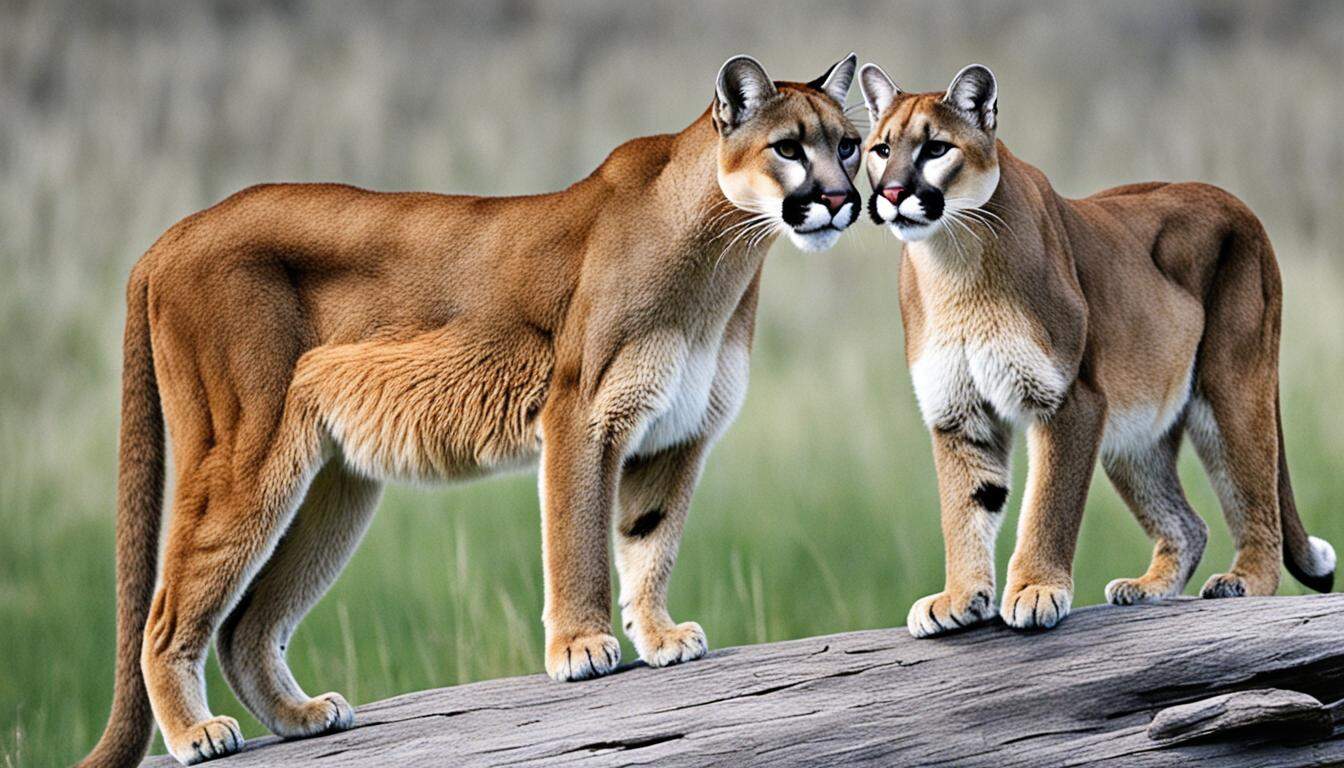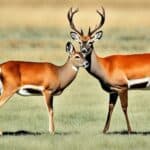Can you spot the difference between a cougar and a mountain lion? They’re both names for the same cool cat, the Puma concolor. They might look a bit different depending on where they live. But, it’s hard to see these differences with the naked eye.
Charlie Jasper knows a lot about keeping predators away. He says the size differences are like the various deer in the U.S. So, tellin’ a cougar from a mountain lion is like noticing tiny differences in how deer look. But overall, they’re very much alike.
Introduction to Cougars and Mountain Lions
In the wild cat world, there’s a lot of talk about cougars and mountain lions. It’s cool that both names point to the same amazing cat – scientifically called Puma concolor. These big cats have a wide area they call home and share a tan coat. They look the same, no matter if you call them a cougar or a mountain lion.
People also use names like puma and catamount for the same cat. But, there is no real difference in how they look. This cat keeps the same features whether you think of it as a cougar or a mountain lion.
So, when we talk about cougars and mountain lions, it’s more about where you are. Different places might use different names. Yet, we all know and love this big cat everywhere in the world.
The Scientific Name: Puma Concolor
The name Puma concolor describes a large cat with a lion-like look. It’s mainly known for its single-colored coat. This helps experts tell the difference between a cougar and a mountain lion.
Origin of the Name
“Puma” comes from South American cultures. It stands for power and smarts. This word is now part of many languages, showing how important this animal is to people around the world.
Meaning of Puma Concolor
Puma concolor means “cat of one color.” It perfectly shows the species’ coat, which is usually one color. This name highlights not just the cat’s looks but also its cultural power. It’s key for telling cougars and mountain lions apart in scientific research.
| Aspect | Puma Concolor |
|---|---|
| Scientific Classification | Puma concolor |
| Common Names | Cougar, Mountain Lion, Panther |
| Cultural Significance | Symbol of Strength and Intelligence |
Geographic Distribution and Habitat
The Puma concolor, more commonly known as the mountain lion, has the largest range among land mammals in the Americas. It lives from Canada down to South America. This shows how well they can live in many different habitats. Learning about the differences between a cougar and a mountain lion helps us know more about where they live and what they like.
Range in the United States
In the U.S., mountain lions are found in many places like forests, deserts, and swamplands. For example, Florida’s Everglades is where the Florida panther lives. This subspecies is very rare. The term cougar vs mountain lion can be confusing but they are pretty much the same animal. They can live in a wide variety of places, like from the north’s forests to the south’s wetlands.
Range in South America
In South America, places like Patagonia show us how mountain lions can adapt to highlands. The Brazilian Pantanal, on the other hand, is a tropical paradise where they also live. Their ability to live across different regions highlights their strength. By understanding where these cats live, we can also learn more about the cougar vs mountain lion debate.
Physical Characteristics of Cougars and Mountain Lions
The majestic cougar, known as the mountain lion, has some amazing features. Even though they may look a bit different depending on the area, they share some key physical traits. Cougars are known for their sleek bodies, round faces, and pointed ears. They have strong bodies, big paws, and strong back legs. These features let them jump high and turn quickly with ease.
Looking at cougar vs mountain lion identification, their looks are all about survival. Their fur can be reddish-brown or change to silver-gray. This depends on where they live and helps them hide. Their different fur colors make them hard to spot, which is great for living in different places. This shows how smart nature is, making cougars fit in well wherever they are.
Size and Weight Differences
Cougars and mountain lions, which are the same species (Puma concolor), vary in size. This difference comes from where they live, what they eat, and the weather around them. Comparing their sizes shows us how well they can adapt and survive.
Regional Variations in Size
The place they live is key in how big cougars and mountain lions get. In the cold northern areas like the northern United States and Canada, they’re bigger. They have thick fur to help them deal with the cold.
In contrast, in areas closer to the equator, they are smaller. This difference is due to the warm climate and easy access to food. These size differences tell us a lot about how these big cats adjust to their surroundings.
Impact of Diet and Climate
What they eat and the local weather also affect their size. A lot of available food means they can grow big. But if food is hard to find, they stay smaller. This is how they use their environment to survive.
For example, being big helps them stay warm in cold places. And being small is better in hot areas to move around easily and stay cool. Puma concolor’s ability to change its body size shows just how adaptable they are.
Coloration: Tawny vs. Silver-gray
Cougars, or mountain lions, come in many colors. These colors help them blend into their homes. This makes them good at hiding from threats.
Color Variations by Region
In dry places, cougars are usually tawny. They look different where plants are dense, with rust-colored fur.
Areas with lots of rocks and snow show a different story. Cougars get gray and silver-gray fur to disappear in those places.
Seasonal Coat Changes
Cougars change colors with the seasons too. In winter, they might get darker fur. This helps them hide in snow and barren lands.
But in summer, they go back to their tawny look. It helps them blend in with the dry, sunny surroundings.
Cougar and mountain lion color variations show how amazing nature is. It equips these animals with perfect camo. They look stunning, whether in tawny tones or silver grays.
Vocalizations and Sounds
Cougars have a powerful presence but can’t roar like you might expect. They make sounds similar to smaller cats. These sounds are very important in their daily lives.
Hissing, Purring, and Growling
Cougars may hiss, purr, and growl to communicate. They do this for marking territory, calling for mates, and when they are defending themselves. Hissing shows they are upset, purring is for comfort, and growling warns others to stay away.
Comparing to Domestic Cats
Looking at how cougars and house cats sound, they’re quite alike. They can’t roar and rely on hissing, purring, and growling. This shows they share more with small cats than big, roaring ones.
This common ground helps us get to know and admire these amazing animals better.
Behavioral Traits
Cougars show interesting behaviors that help them survive. These traits explain how they move in their world and deal with others, like us.
Ambush Predator Strategies
Cougars are masters of surprise attacks. They’re most active at dawn and dusk, using the dim light to their advantage. Their hunting strategy is clear-cut:
- Stalking: With sharp senses, they track prey silently and stay downwind to avoid detection.
- Positioning: Choosing hidden spots or high ground, they blend in with their surroundings.
- Pouncing: They’re quick and powerful, leaping far to take down their prey with a single blow.

Interaction with Humans
Usually, cougars stay away from people. But as we move further into their homes, we see them more. This can lead to tensions.
We can make things better by learning about cougar and mountain lion behaviors and taking precautions. Things like securing animals, making noise, and being alert in cougar areas can help. By doing this and not disturbing their homes, we can share the land peacefully.
Diet and Hunting Techniques
Cougars, the top predators, have a varied food menu that suits their area and the prey they find. While deer is their main meal, they also go after smaller animals. In some places, they even target big animals like elk or moose. This shows how well they can find food in different places.
Types of Prey
Cougars have a wide range of food choices. Besides deer, you might find them hunting:
- Smaller mammals like rabbits and rodents.
- Birds and, sometimes, reptiles.
- Bigger animals like elk and moose in certain areas.
Hunting Adaptations
Their hunting skills are truly amazing. Some of their best hunting tricks are:
- A back that can twist easily, helping in fast turns during hunting.
- They bury some of their catch for a later snack, showing they think ahead.
- They can live and hunt in many different places, from thick forests to wide plains.
Conservation Status and Threats
Cougars, also known as Puma concolor, are facing many threats. These dangers have caused big decreases in certain areas. Places like Florida, home to the Florida panther, are especially affected.
Their cougar conservation status changes based on where they live and the environment around them.
Some key threats to these big cats include habitat loss, fragmentation, prey depletion, and human conflicts. This makes their survival very challenging.
The situation highlights the need for strong conservation actions. This includes protecting their living spaces, changing how hunting is done, and reducing conflicts with people. It’s essential to understand and address the risks cougars face. This way, we can help ensure their future.
Role in the Ecosystem
Mountain lions are crucial for keeping nature’s balance. As top predators, they control the number of prey like deer. This helps keep ecosystems healthy and diverse.
As Charlie Jasper notes, “The ecological balance achieved through the natural behaviors of apex predators like mountain lions is irreplaceable.”
Importance as Apex Predators
The *importance of apex predators* is huge. Mountain lions are top predators. They keep the plant-eating animals in check. This stops one type of animal from taking over and eating too much.
Impact on Prey Population
Mountain lions have a big effect on prey animals. They hunt deer and other animals, which stops diseases from spreading in those groups. This keeps other animal and plant numbers in balance. Without mountain lions, grasslands can suffer from too much grazing, making the habitat sick.
| Role | Effect on Ecosystem |
|---|---|
| Population Control | Prevents overpopulation of herbivores and sustains plant biodiversity |
| Disease Prevention | Reduces the spread of disease by keeping prey populations in check |
| Ecological Balance | Maintains a stable and diverse ecosystem by regulating multiple species |
In conclusion, mountain lions are key to nature’s balance. Knowing how they affect other animals is vital for saving them. Their place in the ecosystem is essential for a healthy planet.
How do you distinguish between a cougar and a mountain lion?
When telling a cougar from a mountain lion, know they are the same species called Puma concolor scientifically. In North America, they go by many names. “Cougar” and “mountain lion” are commonly used.
Despite different names, telling them apart shows they look the same. Both have a tawny coat and a fit body for quick moves. The names they’re called are more about where they live than how they look.
Here is a table that shows what they have in common and where they differ:
| Aspect | Cougar | Mountain Lion |
|---|---|---|
| Scientific Name | Puma concolor | Puma concolor |
| Coat Color | Tawny, sometimes grayish | Tawny, sometimes grayish |
| Geographic Usage | Western regions of North America | Eastern regions, sometimes other places |
| Preferred Terminology | Casual talks in a few states | Used in science and formal talks |
To really tell cougar from mountain lion, understanding these points helps. It’s interesting how names changed over time, based on culture. Yet, they’re talking about the same amazing wild cat.
Conclusion
Cougars and mountain lions are names for the same big cat species, Puma concolor. In North America, it’s often called a “cougar,” while “mountain lion” is used more in the United States. Even though the names change, their features stay the same.
It’s key to know how to spot the difference between a cougar and a mountain lion. They look alike, with big bodies and coats ranging from tawny to silver-gray. Both use similar hunting styles and talk in similar ways, all helping keep the environment in balance.
Protecting cougars and mountain lions is vital for our world. We must save where they live and solve problems like losing homes and dealing with humans. By learning more about them and their role in nature, we can live together better and keep these beautiful animals safe.
FAQ
How do you distinguish between a cougar and a mountain lion?
A cougar and a mountain lion are the same animal. They share the same scientific name, Puma concolor. The choice of name varies depending on where you are.
What are the distinguishing features of a cougar and a mountain lion?
Cougars and mountain lions are the same with a few key features. They have sleek bodies, round heads, and tall ears. Their fur is usually a tawny color, which can vary in shade.
This might include a range from reddish-brown to silver-gray. This depend on the place they live.
What is the scientific name of a cougar/mountain lion and its meaning?
The scientific name for this big cat is Puma concolor. It means “cat of one color.” This fits because they mostly have the same color coat.
Where can cougars and mountain lions be found?
Cougars and mountain lions live from Canada to South America. In the United States, they’re in forests and swamps. They are very adaptable.
How do the size and weight of cougars vary?
Cougars’ size and weight change based on where they are and their diet. Males are often bigger than females. In cold places, they might be heavier.
What are the color variations observed in cougars and mountain lions?
These big cats can be tawny, rust, or gray. They might even be silver-gray. The color depends on their home and can look different each season.
How do cougars communicate?
Cougars use sounds like hissing and purring to talk. They also growl. This sets them apart as they can’t roar like other big cats.
What are some behavioral traits of cougars?
Cougars hunt by surprise, showing how stealthy and powerful they are. They usually avoid people but now and then, they come closer due to human activity.
What do cougars typically eat?
These big cats eat meat, targeting deer and small animals. They can also hunt large game like elk in some places. Their diet helps them live in many different areas.
What threats do mountain lions face?
Mountain lions are vulnerable to losing their homes and food. Human activities put them at risk too. These threats can lower their numbers, as seen with the Florida panther.
How do cougars impact their ecosystem?
As the top predator, cougars keep prey in check. This helps stop diseases from spreading. They are key to a healthy and diverse environment for many animals.
Why might someone confuse a cougar with a mountain lion?
Using both names for the same cat can be confusing. Knowing that they mean the same animal helps clear up this confusion.







